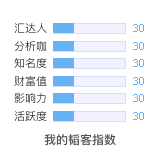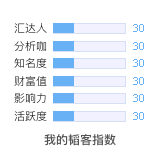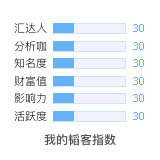[止损止赢]有关止损的问题
[转帖]
[center]Establishing stop loss levels [/center]
Establishing an appropriate stop loss level is the most difficult part of trading and there are several techniques to establish these levels. On one hand, if the stop is too "tight", the probability of being stopped out is very high even if the position is in the "right" direction. On the other hand, losing positions should not be kept too long. So, how should one gauge whether the stop is too "tight" or too "loose" ? Several elements must first be taken into consideration :
- Time frame ;; the trader who is working from 1 hour charts will, of course, have to place his / her stops much looser than the trader working off of 15 minute charts. However, the trader working off of 1 hour charts will necessarily have a bigger objective to compensate and justify this risk.
- Market volatility ;; Though we do not know when the market is going to become very volatile or very calm, volatility (or lack there of it) is like trends ?it stays for a while (or is absent for a while). When the market is generally volatile, stops must be placed looser than when the market is generally calm.
- Support and resistance levels;; the trader working from 15 minute charts should use support and resistance levels to help guide him / her with stop levels. If, for example, the trader is long from 0.9745 and there is good support at 0.9725, it would probably not be a good idea to place the stop any higher than 0.9720 (support level and a bit of room for "noise").
- Previous high / low on a larger time frame ;; The trader working from 15 minute charts may use 1 hour bars / candles to help guide him / her to place the stop level. For example, for long positions established by signals coming from 15 minute charts, the trader mar switch to 1 hour charts and look for a preceding candle with a lower low. The low of that candle could be used as a reference point for the stop level.
- Find the "pivot points" ;; The "pivot point" is the point at which the market turns from bull to bear or from bear to bull. Though this may seem rather subjective, there are often fairly clear horizontal levels at which the market changes direction. These levels often differ from one time frame to another and one may even find several different "pivot points" in the same time frame. The key is to differentiate the "minor support / resistance" levels from the real "pivot points". This is simply a question of observation, practice and experience卼here is no "magic" or mathematical formula for "pivot points". Finally, the "pivot point may not necessarily be a single level, but may be composed of a zone or band but is usually a fairly tight band (depending on the time frame of course). Once the pivot point is established, the trader may want to refer to it as the stop level in the same manner that one would use support and resistance levels (as explained above).
- Finally, one the appropriate stop is established, one must decide if they can actually afford to take the loss in the event that the stop is hit. If the established stop loss would "severely damage" the account, the trade must not be entered. The solution may be either, work on smaller time frames, stand aside until market volatility calms down or simply fund the account adequately。
[ Last edited by goldenmean on 2005-6-13 at 12:12 ]
2楼
[center]如何建立止损价位[/center]
建立合适的止损价位是交易中最困难的部分。现有几种技术可以用来建立止损价位。一方面,如果止损价位离入场价位太近,头寸被强行平仓出局的概率就非常高,即使交易的方向完全正确。另一方面,失败的头寸不应保留太长时间。所以,如何确立建立止损价位是太近或太远呢?一般来说,可以从以下几个方面考虑。
-----时间框架。按照小时图交易当然比按照15分钟图交易的止损价位要远。想比而言,前者应有更高的目标价位以弥补潜在的损失而使更高的风险合理化。
----市场震荡性。即使不知道市场将变得非常振荡或非常平静,震荡性或无振荡性是像趋势吗?市场时而震荡时而平静。通常情况下,当市场振荡时,止损价位应比平静状态设立地更远。
-----支持及阻力水平。使用15分钟图表的交易者应该应用支持及阻力价位帮助他们建立止损价位。假如交易者在0。9745建立欧员多头头寸,在0。9725具有良好支持,那么止损价位设立在0。9720以上就不是一个好主意(由于噪音的存在和支持水平)。
----更长交易框架的前期高点及低点。使用15分钟图建立入场价位的交易者可以使用小时图帮助设立止损价位。例如,根据15分钟图表发出的买入信号建立多头头寸的交易者,可以结合小时图发现前期更低的低点,
这个价位可做为止损的参考价位。
----发现关键点位。关键点位是指市场从牛到熊或从熊到牛的转折点。即使这似乎显得相当主观,但是市场确实在某些地区相当清晰的水平区域发生趋势改变。这些关键点位常随着时间的变化而改变,所以在相同的时间框架内可存在多个不同的关键点位。问题的核心是如何分辨关键点位和弱支持和弱阻力价位。遗憾的是,这里并不存在什么魔力和数学公式可以帮助我们发现它们,而只有依赖交易者不断的观察,实践和经验。最后,关键点位也不是单一的点位,而是由多个不同的区域或条带所组成,这些条带常常非常精密(依赖于时间框架)。一旦建立了关键点位,交易者可以依此设立止损价位,如同使用支持和阻力价位一样。
---最后一点,当建立止损价位后,交易者必须决定自己能否承受这样的损失一旦被止损,如果建立的止损价位会重创你的户头,交易者就不应该
建立头寸。如果你确实想交易,那么就在更小的时间框架内操作,或者在你的户头上注入更多的资金。当然,你也可以选择旁观,待市场平静后再重新决定进场与否。
[此帖子已被 goldenmean 在 2004-9-24 12:42:08 编辑过]
外汇交易的最大魅力在于能够满足我们探索未来未知世界的迫切欲望
发表于:2005-06-11 15:05只看该作者
3楼
从头学起
韬客社区www.talkfx.co
发表于:2005-06-15 13:48只看该作者
4楼
正是我所想学习的问题 谢谢
韬客社区www.talkfx.co












